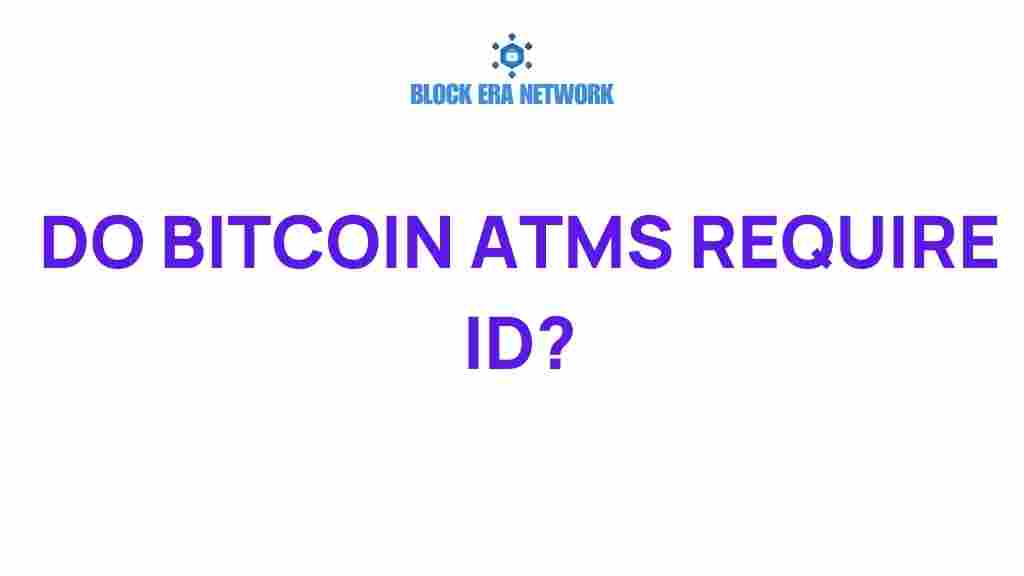Do Bitcoin ATMs Require ID?
As the world of cryptocurrency continues to expand, many users are curious about the nuances of using Bitcoin ATMs. One of the most pressing questions is whether these machines require identification. This article aims to unravel the mystery behind transactions at Bitcoin ATMs, focusing on identification requirements, user experience, and the regulations that govern these financial transactions. We’ll also explore the implications for privacy and security in the blockchain ecosystem.
Understanding Bitcoin ATMs
Bitcoin ATMs are specialized machines that allow you to buy or sell Bitcoin using cash or debit cards. Unlike traditional ATMs that dispense cash, these machines facilitate cryptocurrency transactions. As the popularity of Bitcoin has surged, so has the number of Bitcoin ATMs, making it easier for users to engage in financial transactions with cryptocurrency.
The Rise of Bitcoin ATMs
In recent years, Bitcoin ATMs have become increasingly common in urban areas around the globe. Their rise can be attributed to several factors:
- Increased accessibility to cryptocurrencies.
- Growing interest in digital currencies.
- Convenience of purchasing Bitcoin in-person.
However, with this increased usage comes questions about the requirements for using these ATMs, particularly concerning identification.
Identification Requirements at Bitcoin ATMs
One of the primary concerns users have is whether they need to provide ID when using Bitcoin ATMs. The answer isn’t straightforward, as it can vary based on several factors:
1. Type of Transaction
There are generally two types of transactions you can perform at a Bitcoin ATM:
- Buying Bitcoin: Most ATMs require some form of identification, especially for larger transactions.
- Selling Bitcoin: Selling may require identification as well, though some machines allow smaller transactions without it.
2. Machine Provider Policies
Different providers have different policies regarding identification:
- Some Bitcoin ATMs may require ID for all transactions.
- Others may allow smaller purchases without ID but require it for transactions over a certain threshold.
- Some locations might not require ID at all.
3. Local Regulations
Identification requirements can also depend on local laws. In many jurisdictions, financial regulations mandate that cryptocurrency providers comply with Know Your Customer (KYC) rules. This means:
- Users may need to show ID if the transaction exceeds a certain amount.
- Some jurisdictions may have stricter identification laws than others.
How to Use a Bitcoin ATM
Using a Bitcoin ATM can be a straightforward process. Here’s a step-by-step guide:
Step 1: Locate a Bitcoin ATM
Use a Bitcoin ATM map service to find a nearby machine. Websites like CoinATMRadar provide comprehensive listings of Bitcoin ATMs.
Step 2: Prepare Your Wallet
Before you approach the ATM, ensure you have a cryptocurrency wallet ready. You can use:
- Mobile wallets (apps on your smartphone).
- Hardware wallets (physical devices for storing crypto).
Step 3: Initiate the Transaction
At the ATM, follow these steps:
1. Choose whether you want to buy or sell Bitcoin.2. If buying, enter the amount you wish to purchase.3. If selling, enter the amount you want to exchange for cash.
Step 4: Provide Identification (if required)
If the machine requires ID, you will be prompted to scan your identification document, such as a driver’s license or passport. Follow the on-screen instructions to complete this step.
Step 5: Complete Your Transaction
Once your ID is verified (if required), the ATM will process your transaction. If you are buying Bitcoin, you will receive a QR code to scan with your wallet app. If selling, you will receive cash.
Troubleshooting Common Issues
While using Bitcoin ATMs is generally user-friendly, you may encounter some issues. Here are some common problems and how to resolve them:
1. ATM Not Recognizing Your Wallet
If the ATM does not recognize your wallet, ensure:
- Your wallet app is up-to-date.
- You have generated a valid receiving address.
2. Identification Not Accepted
If your ID is not accepted, check that:
- The ID is not expired.
- The machine supports the type of ID you are using.
3. Transaction Failed
In case of a failed transaction, consider the following:
- Check your internet connection.
- Ensure the ATM has sufficient liquidity for cash withdrawals.
The Impact of Regulations on User Experience
The landscape of cryptocurrency regulations is continuously evolving. These regulations directly impact the user experience when using Bitcoin ATMs. Here’s how:
Enhanced Security
While regulations can make transactions more cumbersome due to ID requirements, they also enhance security. By adhering to KYC and Anti-Money Laundering (AML) regulations, Bitcoin ATMs help prevent fraud and illicit activities.
Privacy Concerns
On the flip side, the requirement for identification can raise privacy concerns among users who value anonymity in their financial transactions. Some users prefer to use ATMs that do not require ID to maintain their privacy.
Future of Bitcoin ATMs
As the cryptocurrency market matures, it is expected that more regulations will come into play. This could lead to:
- Stricter identification requirements.
- Increased availability of Bitcoin ATMs with various compliance levels.
- Greater emphasis on user education regarding compliance and security.
Conclusion
In conclusion, whether Bitcoin ATMs require ID depends on various factors such as the type of transaction, the machine provider’s policies, and local regulations. While some machines may allow for anonymous transactions, many will require identification to comply with legal standards. Understanding these requirements is crucial for ensuring a smooth and secure user experience.
As cryptocurrency continues to gain traction, staying informed about the regulations and identification requirements surrounding Bitcoin ATMs is essential for all users. For further information on cryptocurrency regulations, visit CoinDesk.
To explore more about how to use Bitcoin ATMs effectively, check out our guide at Crypto Guides Online.
This article is in the category Cryptocurrency Insights and created by Block Era Network Team
